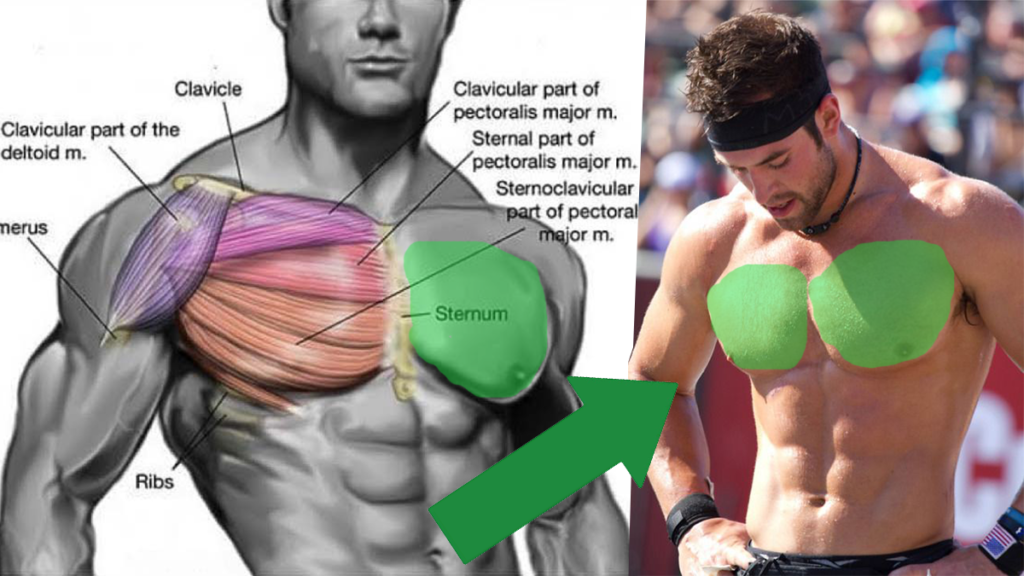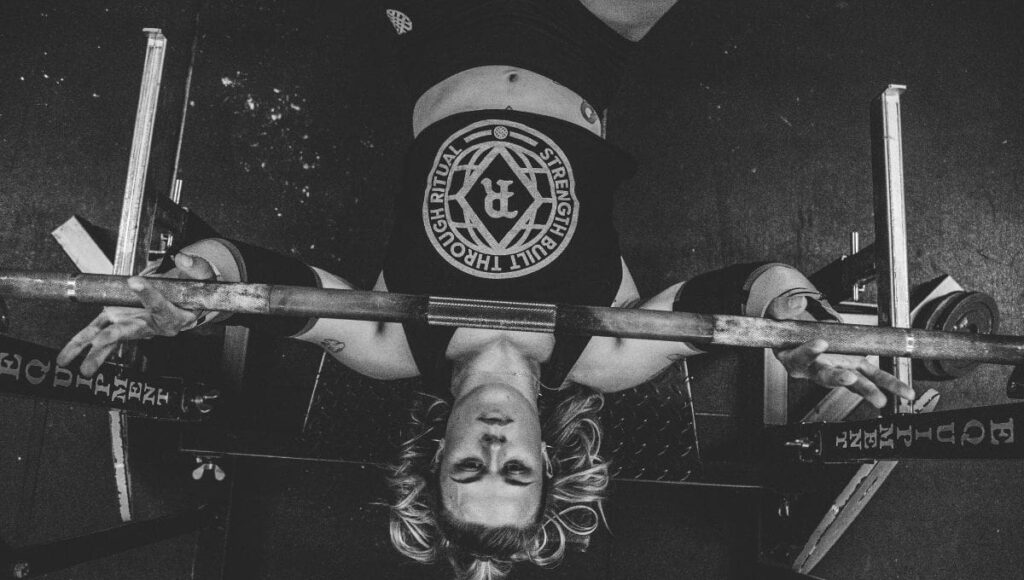This is the best way to isolate the upper chest for significant muscle growth according to Jeff Nippard.
Jeff Nippard is a natural professional bodybuilder and fitness coach who shares tips and training programs on his YouTube channel.
The information you are about to see was taken from a video uploaded by Nippard in a series he called “technique Tuesday.” In this episode of Technique Tuesday, fitness expert Jeff Nippard delves into the realm of effective chest isolation exercises, shedding light on various variations to maximize chest development with a focus on the upper part of the chest.
The Best Way to Isolate the Upper Chest for Significant Muscle Growth
 Source: Depositphotos / CrossFit Inc
Source: Depositphotos / CrossFit IncJeff begins by emphasizing the foundational importance of compound movements like the bench press and weighted dips for overall chest growth. However, he introduces the concept of isolation exercises, particularly the fly, as a strategic tool to address specific chest imbalances or target lagging areas.
The primary objective of any fly movement is to induce horizontal shoulder adduction, which involves bringing the arm across the body. This motion mirrors elements of a bench press or dumbbell press, albeit with a consistent elbow angle that isolates the chest muscles more effectively. By minimizing triceps involvement, the fly activates the chest muscles to a greater extent.
Jeff stresses that targeting the upper chest can be achieved by introducing shoulder flexion to the movement. This component, often associated with the incline bench press, taps into the clavicular head of the pectoral muscles, enhancing its activation and growth potential. To facilitate this movement pattern, Jeff recommends performing cable flies instead of relying solely on dumbbells or traditional pec deck machines.

The advantages of cable flies lie in their ability to maintain consistent tension throughout the range of motion. Unlike dumbbells, where tension fluctuates, or the pec deck, which lacks the freedom of movement, cables provide a more dynamic and adaptable resistance curve. This adaptability allows for the manipulation of angles and arm positions, enabling precise targeting of different chest regions.
Jeff demonstrates how to set up cable flies effectively. He advises starting with the cables low, adjusting arm angles to 15 to 30 degrees for optimal upper chest targeting. The stance is equally crucial, ensuring a stable base for balanced execution. To initiate the positive phase, Jeff emphasizes retracting and depressing the shoulder blades, replicating the scapular position during a bench press. This engagement optimizes chest contraction during the lift.
It’s important to internally rotate the shoulders during the positive phase and externally rotate them during the negative phase to activate the pectoral muscles to their fullest potential.
Maintaining proper scapular position and control is vital to prevent triceps takeover and achieve effective isolation.
Jeff underscores that the cable fly is intended as a supplementary exercise, designed to complement compound movements within a well-rounded chest routine. With an emphasis on the mind-muscle connection, this isolation exercise is suitable for higher rep ranges, typically ranging from 15 to 20 reps, aiming for an intense pump and muscle engagement.
Furthermore, Jeff introduces creativity into the cable fly routine by suggesting variations that target different areas of the chest. He proposes adjusting the cable height to modify the emphasis on the lower, middle, or upper pecs, thus enabling a more comprehensive chest workout. Additionally, Jeff introduces the concept of intensity techniques, such as cable fly 21s, which involve segmented repetitions to amplify metabolic stress and enhance muscle engagement.

Throughout the instructional video, Jeff addresses common errors and provides practical guidance for impeccable cable fly execution. He emphasizes the significance of controlled movements, avoiding triceps dominance, and retaining scapular retraction. By adhering to these principles, individuals can effectively harness the benefits of cable flies to achieve a well-rounded and balanced chest development.
In conclusion, Jeff Nippard’s Technique Tuesday episode delves into the intricacies of the cable fly exercise, shedding light on its potential for targeted chest development. Through detailed explanations, demonstrations, and practical recommendations, Jeff equips viewers with the knowledge and tools to incorporate cable flies into their chest training regimen strategically. Aspiring fitness enthusiasts and seasoned athletes alike can benefit from Jeff’s expert insights, optimizing their chest workout routines for superior gains and a well-defined physique.
For a deeper analysis and more information on the matter, watch Nippard’s video below regarding the best way to isolate the upper chest for significant muscle growth.
2 Great Upper Chest Exercises for Muscle Growth
7 Rare Upper Chest Exercises for Incredible Muscle Gains (Look Good Get Strong)
Upper Chest Exercises Ranked (BEST TO WORSE)
Learn More
Training your chest can have a number of benefits for your overall fitness and physical health. Here are some reasons why you might want to train your chest:
- Strengthening your chest muscles: Chest exercises like bench press, push-ups, and dumbbell flyes can help you build stronger chest muscles. This can improve your overall upper body strength and make it easier to perform daily activities that require pushing or pulling.
- Aesthetics: A well-developed chest can enhance the appearance of your upper body, giving you a more balanced and proportional physique.
- Improved posture: A strong chest can also help improve your posture by pulling your shoulders back and helping you maintain a more upright position.
- Increased metabolism: Chest exercises can also help boost your metabolism, which can help you burn more calories throughout the day.
- Improved athletic performance: A strong chest can improve your performance in a variety of sports and activities that require upper body strength, such as basketball, football, and rock climbing.
 Source: Photos Courtesy of CrossFit Inc
Source: Photos Courtesy of CrossFit IncOverall, training your chest can have numerous benefits for your physical health, appearance, and athletic performance. It’s important to incorporate a variety of exercises into your chest workout routine to ensure that you’re targeting all the muscles in your chest, as well as other muscles in your upper body.
10 Push-Up Variations to Build Strength, Power and Muscle
From Training to Failure to Eating Clean: Explaining Controversial Fitness Topics
How to Increase Chest Size and Strength
How Often Should You Train the Chest?
The frequency at which you should train your chest depends on several factors such as your fitness goals, overall fitness level, and your training program.
In general, it is recommended that you train your chest muscles at least once per week to see improvements in strength and muscle growth. However, some individuals may benefit from training their chest more frequently, such as 2-3 times per week, especially if they are more experienced lifters and are looking to target specific areas of the chest.
It’s important to note that you shouldn’t train your chest muscles on consecutive days as this can lead to overtraining and increase the risk of injury. Additionally, it’s important to allow your muscles to rest and recover between workouts, so that they have time to repair and grow.

Overall, the frequency at which you should train your chest will depend on your individual goals and fitness level, so it’s best to consult with a certified fitness professional who can help you design a personalized workout plan that meets your needs.
5 Steps to Build a Perfect Male Physique
5 Testosterone-Boosting Foods Men Must Eat
How Heavy Should you Lift When Training for Muscle Growth?
When training for muscle growth (hypertrophy), the weight you lift, often referred to as the training load or intensity, is an important factor to consider. Here are some guidelines to help determine how heavy you should lift:
Use a weight that challenges you: To promote muscle growth, it’s important to use a weight that challenges your muscles. This means selecting a weight that allows you to complete the desired number of repetitions within the hypertrophy rep range (generally 8 to 12 reps) with proper form, while also feeling challenging towards the end of each set.
Choose a weight that elicits fatigue: The weight you select should cause fatigue in the target muscles by the end of each set. You should feel a sense of muscular burn or fatigue during the final few reps, indicating that the weight is appropriately challenging.
Progressive overload: To continue building muscle, it’s crucial to gradually increase the demands on your muscles over time. This can be achieved through progressive overload, which involves gradually increasing the weight you lift as your muscles adapt and grow stronger. Aim to progressively increase the weight as you become more comfortable with a certain weight range to continue stimulating muscle growth.
Form and technique: While it’s important to challenge yourself with heavier weights, it’s equally important to prioritize proper form and technique. Lifting weights that are too heavy and compromise your form can increase the risk of injury and reduce the effectiveness of the exercise. Focus on maintaining good form throughout each repetition, even when using challenging weights.
 Source: Scott Webb
Source: Scott WebbIndividual capabilities: The appropriate weight will vary depending on your individual capabilities, strength level, and experience. What may be heavy for one person might be light for another. It’s important to listen to your body and select weights that are appropriate for your current fitness level.
Variation in training: Incorporating a variety of rep ranges and training modalities can be beneficial for overall muscle development. While the hypertrophy rep range (8-12 reps) is commonly associated with muscle growth, including both higher rep ranges (12-15+) and lower rep ranges (6-8) in your training can provide different stimuli and promote well-rounded muscle development.
Remember, finding the right weight is a process of trial and error. Start with a weight that challenges you within the recommended rep range, and adjust as needed based on your individual capabilities and progression. Consulting with a fitness professional or personal trainer can also provide guidance and help you determine the appropriate weight selection for your specific goals and needs.
17 Brutal Upper Body Workouts for CrossFit Athletes and Fitness Fanatics
The Best Home Chest Dumbbell Workout
This content is originated from https://www.boxrox.com your Online Magazine for Competitive Fitness.